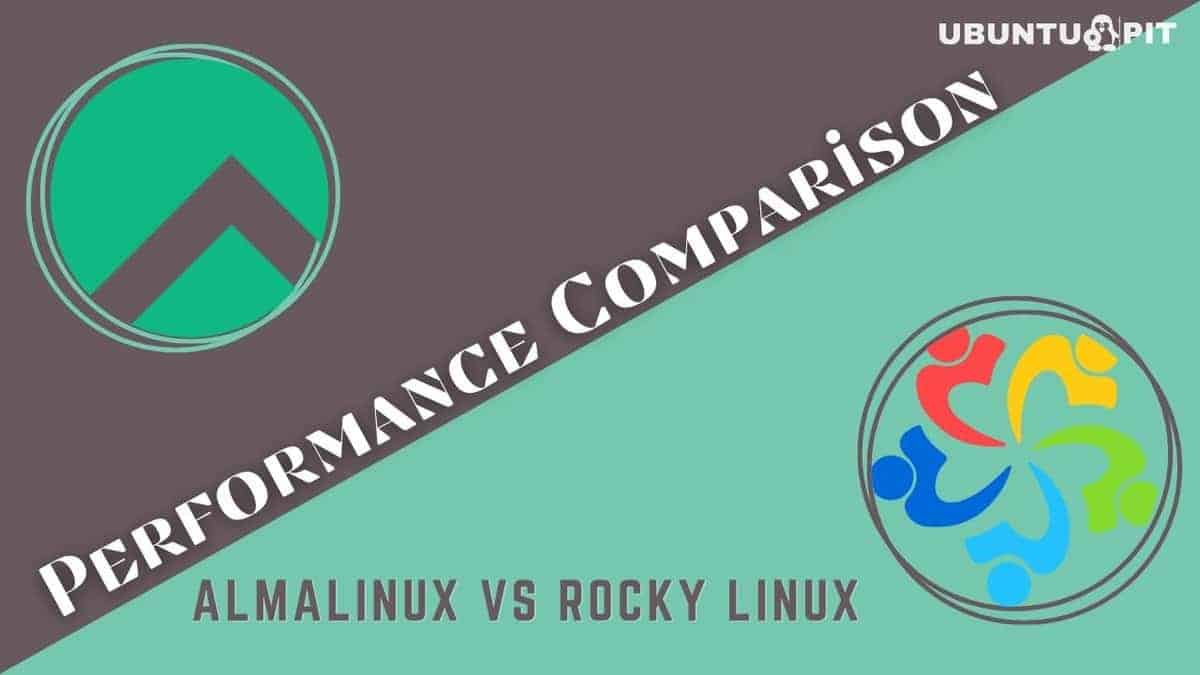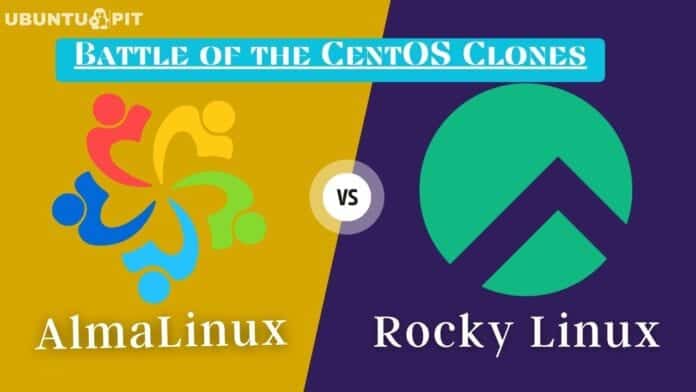CentOS Linux was a long-standing, popular choice for users seeking free and open source Linux distribution. Based on Red Hat Enterprise Linux (RHEL), it offered stability and reliability in an easy-to-use package. In 2021, after nearly 18 years of service, CentOS announced its end of life and would no longer be available as an operating system.
This left a large number of users searching for an alternative Linux distribution that could provide the same features and tools as CentOS. To fill this gap, two new distributions have emerged: Almalinux and Rocky Linux.
Whether to choose Rocky Linux or Almalinux can create confusion for users. To help them out, we created this article on the differences between Rocky Linux and Almalinux so that they can make an informed decision about which one is best suited for their needs.
What is Almalinux?
AlmaLinux is a community-driven Linux distribution developed as an alternative to CentOS. It aims to provide users with the same stability and reliability as the original distribution while also offering new features and updates. AlmaLinux has been designed specifically for servers and desktops, making it a versatile choice for many different use cases.
Advantages:
- Includes stable, feature-rich packages and libraries that are optimized for server workloads.
- Has an extensive support network of users and developers who can provide valuable advice and assistance when needed.
- Utilizes the same build system as Red Hat Enterprise Linux, making it easy to transition from CentOS.
- Offers a comprehensive security model that is constantly updated for maximum protection against the latest threats.
Disadvantages:
- Can be challenging for newcomers with little or no Linux experience.
- Does not offer as many packages as other distributions, such as Ubuntu or Debian.
What is Rocky Linux?
Rocky Linux is another new release developed as a fork of CentOS 8. It uses the same source code as Red Hat Enterprise Linux but with a few tweaks to improve performance and stability. Rocky Linux also offers many of the same features and tools that made CentOS so popular with users.
Advantages:
- Open source, so it can be modified to fit specific needs.
- Easy to use and set up in comparison to other distributions.
- Backed by an active community of developers who are constantly improving the platform.
- Includes a wide range of packages and libraries optimized for server workloads.
Disadvantages:
- Still in its early stages, so not all features are available yet.
- Can be difficult to migrate from CentOS if unfamiliar with Linux systems.
AlmaLinux vs Rocky Linux: Key Differences
Although both operating systems are derived from RHEL, there is much more to them than meets the eye. Below we will compare their key features and contrasts in order to help you make an informed decision when it comes to selecting between these two amazing options:
1. Build Systems

Rocky Linux and AlmaLinux are both generated with specialized building methods. For developing its assets, AlmaLinux is equipped with a specially crafted AlmaLinux Build System (ALBS). The very first build on build.almalinux.com was initiated on September 15th, 2021 – demonstrating the power of ALBS!
Prior to version 9.0, the Rocky Release Engineering team utilized Koji and other Fedora components to create Rocky Linux. However, upon the release of RL 9.0, Rocky’s own Peridot became the new build system which caused much of the delay with regard to its launch date. Nonetheless, Proof stands as a testament that this switch was invaluable for creating quality software moving forward!
2. Almalinux vs Rocky Linux: Life Cycle
Both Rocky Linux and AlmaLinux are designed around a long-term support model, where users can depend on the same code base and features for up to 10 years. This ensures that users have no need to upgrade major components regularly and keeps their workloads running smoothly without interruption.
3. Desktop Environment
AlmaLinux and Rocky Linux are two robust Linux distributions crafted with enterprises in mind. Out of the box, neither offers a desktop environment; nevertheless, users can easily install one atop each distribution should they wish to leverage them as desktops too.
No matter what their preferences are, users of AlmaLinux and Rocky Linux can select a desktop environment that fits them perfectly. These two operating systems offer compatibility with some of the most popular environments out there, such as GNOME, KDE, and XFCE – to name just a few!
It is essential to understand that while these two OSs can be used as a desktop versions, their focus primarily remains on stability, security, and performance for server systems. For this reason, they may not have the same number of features or applications geared toward desktop users as other Linux distributions, which are specifically designed for desktops and laptops.
4. Updates and Release Cycle
With AlmaLinux and Rocky Linux, keeping your system secure has never been easier, as users no longer need to go through the time-consuming process of a full system upgrade. Both distributions follow a rolling release model which provides users with regular updates so that their systems are always up-to-date!
AlmaLinux and Rocky Linux, both based on the same upstream source code as Red Hat Enterprise Linux, enable users to receive updates quickly. Nevertheless, when these updates are delivered depends on many aspects, such as the complexity of the update or how much resources are available for their development team.
To reduce the delay of update releases, AlmaLinux and Rocky Linux have a team of developers who focus on testing and incorporating updates as quickly as possible. These updates are precisely inspected to guarantee that they don’t cause any issues or problems for users. After the tests and integration process is complete, these upgrades become available through their respective distribution’s update repositories.
As for release cycles, both AlmaLinux and Rocky Linux aim to provide stable and reliable releases. However, they do not have a fixed release cycle like other Linux distributions. Instead, new versions are released when they are ready and have been thoroughly tested. This means that the time between releases can vary depending on the state of development and testing.
5. Migration Tools
For any CentOS user considering the switch to AlmaLinux or Rocky Linux, migration tools are available to make the transition hassle-free and efficient. These automated processes can guarantee a smooth transfer with no disruption in service.
The AlmaLinux migration tool is a command-line tool that allows users to migrate from CentOS 7 or 8 to AlmaLinux. It can detect installed packages, configurations, and repositories on the CentOS system and migrate them to AlmaLinux. The tool is also designed to work with automation tools like Ansible, making it easier to automate the migration process.
Rocky Linux also provides a migration tool called migrate2rocky. The migrate2rocky tool is a simple script that can be run on a CentOS system to migrate to Rocky Linux. It detects the installed packages, repositories, and configurations on the CentOS system and migrates them to Rocky Linux. The tool also provides users with the option to exclude specific packages or files from the migration process.
6. Almalinux vs Rocky Linux: Performance Comparison

When comparing the performance of Almalinux and Rocky Linux, it is important to note that both have their own advantages and disadvantages. Both distros are based on RHEL (Red Hat Enterprise Linux) and CentOS (Community Enterprise Operating System).
When it comes to performance, Rocky Linux has been designed for optimal speed, scalability, and stability. It uses the same Linux core as Red Hat Enterprise Linux and CentOS but with a focus on performance.
This makes Rocky Linux faster than Almalinux in certain areas, such as booting up and running programs. Additionally, Rocky Linux supports more modern technologies like systemd for process management, which can result in improved performance when compared to Almalinux.
In contrast, Almalinux is designed for stability more than performance. It uses an older Linux core than Rocky Linux, which can result in slower performance when compared to its counterpart. Additionally, Almalinux does not support as many modern technologies as Rocky Linux and, therefore, may not run certain programs as efficiently.
7. Development Process
Rocky Linux and AlmaLinux take contrasting approaches when constructing their distributions, diverging in terms of upstream source, building process, and support for various architectures.
CloudLinux’s offspring AlmaLinux, sources from the company’s present “RHEL clone” while Rocky Linux relies on the Red Hat public git repository as its main origin. CloudLinux is apparently drawing data right from Red Hat’s open-source codebase anyway.
8. Almalinux vs Rocky Linux: Security
Not only is security paramount in AlmaLinux and Rocky Linux, but the two offer a variety of distinct security features to keep your data safe.

AlmaLinux boasts OpenSCAP, a powerful tool that scans your system for vulnerabilities in an automated manner. Moreover, through the use of CIS Benchmark, you can implement ideal security settings tailored to your device and get a comprehensive analysis of any potential security issues.
Built with cutting-edge technology from the Center for Internet Security (CIS), these benchmarks guarantee optimal protection against existing and emerging cyber threats.
Rocky Linux has recently achieved a significant security accomplishment – it was added to the NIST Implementation Under Test List for meeting Federal Information Processing Standard Publication 140-3 (FIPS 140-3) criteria. FIPS 140-3 is an essential U.S. government computer security standard necessary for applications requiring heightened levels of protection and safety.
9. Stability
The stability of both Rocky Linux and AlmaLinux is, in general, quite impressive. Both distributions are based on RHEL (Red Hat Enterprise Linux) and CentOS (Community Enterprise Operating System). This means that they have access to the same stable and secure software repositories that all other enterprise-grade operating systems use.
Both OSes were created with one goal in mind: to supplant CentOS. Their major advantage lies in offering unparalleled stability. After Red Hat stopped supporting CentOS, they decided to provide updates for its successor, CentOS Stream, as a rolling release; however, this posed some risks of bugs and glitches that had to be addressed before the RHEL version received it and subsequently, AlmaLinux and Rocky Linux adopted the update too.
With AlmaLinux and Rocky Linux, users can be certain that their system will remain stable despite taking longer to release updates due to the meticulous process of eliminating any risk of unstable software. As a result, user trust and confidence in these two distributions are growing steadily as they offer the same stability features as CentOS used to have before its discontinuation.
10. Rocky Linux vs Almalinux: Architecture Support
AlmaLinux and Rocky Linux are both 1:1 bug-for-bug binary compatible forks of RHEL, utilizing its source code. With the most recent version, they have extended their support to x86_64, aarch64, ppc64le, and s390x architectures – though with different timelines for each architecture.
While AlmaLinux included s390x in this release but was late to include aarch64 (introducing it only in v8.4), Rocky Linux had added aarch64 since inception yet lagged behind when it came to ppc6l2e and s390x, which were introduced later on in version 9.0.
11. RHEL compatibility
Another important area to compare AlmaLinux and Rocky Linux is their compatibility with Red Hat Enterprise Linux (RHEL). Both distributions are forks of RHEL, meaning they share the same core source code and are designed to be 1:1 compatible.
This allows AlmaLinux and Rocky Linux users to take advantage of any existing RHEL systems as well as any software repositories or tools that run on RHEL.
Moreover, both distributions offer a certified compatibility certification with Red Hat Enterprise Linux. This certification is intended to ensure that users can migrate smoothly from RHEL to AlmaLinux or Rocky Linux without having to face any compatibility issues.
With this certification, users can have the assurance that their applications and tools will run without any hiccups when they switch their system over to AlmaLinux or Rocky Linux.
12. Rocky Linux vs Almalinux: Purpose
AlmaLinux and Rocky Linux were both created in order to provide a reliable, secure, and stable alternative to CentOS. AlmaLinux and Rocky Linux are OSes designed with the enterprise user in mind – providing features such as support for multiple architectures, compatibility with RHEL, FIPS 140-3 compliance, and more. In addition to this, both distributions are open source and free to use.
While AlmaLinux is designed as a long-term replacement for CentOS, Rocky Linux was created with the sole purpose of replacing RHEL. As such, Rocky Linux aims to provide similar features and benefits that users get from RHEL, such as reliability, stability, and support.
13. Package Managers
AlmaLinux utilizes the dnf package manager as its default. This package manager allows users to check for updates from official and third-party repositories. On the other hand, Rocky Linux leverages either rpm or dnf package managers that are suitable with RedHat-based distributions such as Fedora, CentOS, etc., along with RockyLinux and AlmaLinux itself. The successor of yum is known to be dnf which can handle both remote and local RPM packages.
14. Repositories
The distinctive AlmaLinux and Rocky Linux are preloaded with three essential repositories: BaseOS, AppStream, and Extras for complete functionality. Specifically, the BaseOS includes a collection of core packages; the AppStream offers additional applications like runtime languages or databases, while the Extras contain programs not obtainable in RHEL.
Manual activation is required for other repositories. In AlmaLinux, the Vault repository has OS versions before this one and packs/ISO images to match. For Rocky Linux, there are multiple repositories authorized by community members, like Extras, Plus, RT (real-time), NFV, etc., in the Extra repository only. Even old versions can be found in these directories if downgrading becomes necessary at some point too.
15. Almalinux vs Rocky Linux: Use Cases
For businesses and organizations that are looking for reliable Linux distribution, AlmaLinux OS is the perfect solution. Not only does it provide excellent performance, but it’s also free of cost! It was created using RHEL source code, so you know you’re getting an enterprise-grade operating system without spending any money.
Not only is AlmaLinux a reliable and stable operating system for server use, but it can also be used to create an optimized architecture that is secure and tailored to your applications. Its versatility allows you to utilize it in physical, virtual, or cloud-based environments with ease.
Rocky Linux is the perfect option for organizations of all sizes, providing an alternative to CentOS and RHEL with its hyper-scale, cloud, and high-performance computing capabilities. This advanced operating system possesses a myriad of exceptional features that are certain to satisfy any large organization’s needs.
Rocky is an outstanding server solution that offers reliability, optimal performance, and integration with almost all control panels. Furthermore, medium-sized enterprises can make use of this cost-effective alternative as it provides RHEL features at no cost.
Not just made for enterprises, AlmaLinux and Rocky Linux are ideal for private use, too, given their user-friendly interface and the fact that they are absolutely free!
16. Rocky Linux vs Almalinux: Learning Curve

If you are familiar with CentOS or RHEL, AlmaLinux, and Rocky Linux will be a breeze to learn. Both operating systems were established in 2021 after the abrupt announcement of CentOS’s end-of-life, but they offer an easy installation process that only requires a few steps through their GUI.
However, if you have not used either of these before, mastering Linux can be intimidating. For this reason, we recommend taking some time to understand basic Linux commands before making the leap into one of these new OSes.
17. Corporate Backing
CloudLinux, the founding organization of AlmaLinux, is committed to providing an impressive $1 million annually for project growth and maintenance. Moreover, this open-source operating system currently has twenty-one partners and sponsors, along with one commercial support vendor – TuxCare. With notable backers such as Microsoft, AWS, Equinix, cPanel, and AMD supporting the OS, it’s certainly no wonder why AlmaLinux continues to thrive!
Rocky Linux, developed and funded by Kurtzer’s CIQ company with a whopping $26 million in backing, is proudly sponsored by MontaVista and OpenLogic. The open source operating system has garnered the recognition of several large corporations such as Google, AWS, Microsoft Azure, and VMware for its impressive achievements.
The widespread and continually increasing support for the distributions acts as a driving force behind the success of both Operating Systems.
18. Rocky Linux vs Almalinux: Community Support
Gregory Kurtzer, a co-founder of CentOS Linux, founded the incredibly dependable Rocky Enterprise Software Foundation (RESF), which is a Public Benefit Corporation dedicated to building an open and trustworthy community around enterprise software.
The RESF consists of team leads from the Rocky Linux network who have proven their reliability in order to promote transparency and diminish any chance that control will be taken away from those rightfully running it.
The AlmaLinux OS Foundation is a 501(c)(6) non-profit that provides the public with an open-source, stable Linux distribution – completely free of charge and without registration.
They strive to facilitate the growth of a community dedicated to delivering solutions based on or complementary to this operating system through Contributor Members, Mirror Members, Sponsor Members, and Alumnus Member relationships. By doing so, they work hard at further developing and maintaining AlmaLinux OS for everyone’s benefit.
The user base of both distributions is steadily increasing, showing that the community continues to expand and remain actively engaged in developing the operating systems.
19. Cloud Provider Marketplace Availability
AlmaLinux is available on major cloud providers such as Azure, Google Cloud Platform, Amazon Web Services, and many more. Rocky Linux also offers its open-source operating system to the same popular cloud providers as AlmaLinux.

The availability of both distributions across multiple cloud providers makes it easier for users and businesses to access the operating systems they need. Either distribution can be quickly installed on any of these services, giving you a reliable platform that can be used in production or development environments.
AlmaLinux vs. Rocky Linux: Which One to Go With?
Both AlmaLinux and Rocky Linux are robust, reliable operating systems that have been gaining widespread popularity in the open-source community. Both distributions offer a straightforward installation process, numerous backing organizations and corporate sponsors, expansive cloud provider availability, and a growing user base. Deciding which one to go with ultimately boils down to personal preference.
If you prefer the stability and security of an enterprise-grade operating system, then Rocky Linux might be the right choice for you. If you want more control over the features and functionality of your OS, AlmaLinux could be a better fit. Whichever you choose, both distributions have proven to be excellent choices for anyone looking for a reliable open source Linux operating system.
FAQ: AlmaLinux vs. Rocky Linux
Q: Which is more reliable, AlmaLinux or Rocky Linux?
A: Both distributions are extremely reliable and have proven to be excellent choices for anyone looking for a dependable open-source operating system. Ultimately it comes down to personal preference.
If you prefer the stability and security of an enterprise-grade OS, then Rocky Linux might be the right choice for you. If you want more control over the features and functionality of your OS, AlmaLinux could be a better fit.
Q: What cloud providers are both distributions available on?
A: Both AlmaLinux and Rocky Linux are available on major cloud providers such as Azure, Google Cloud Platform, Amazon Web Services, and many more. The availability of both distributions across multiple cloud providers makes it easier for users and businesses to access the operating systems they need.
Either distribution can be quickly installed on any of these services, giving you a reliable platform that can be used in production or development environments.
Q: What are the differences between AlmaLinux and Rocky Linux?
A: There are numerous differences between AlmaLinux and Rocky Linux, but the main one is that AlmaLinux is a rebuilt version of CentOS, whereas Rocky Linux is a clone of Red Hat Enterprise Linux (RHEL). Other differences include the package managers used in each, the organizational backing for each system, and cloud provider availability.
Finally, Insights!
In this article, a comparison between AlmaLinux and Rocky Linux was made clear. To understand the differences between these two systems, 19 distinct topics were discussed in-depth to illustrate their individual paths toward reaching the same goals.
Although AlmaLinux and Rocky Linux are similar, their management and control vary significantly. Therefore, if you need an RHEL-based substitute, AlmaLinux is highly recommended due to its funding system which makes it the more favorable choice of the two distributions.
Moreover, AlmaLinux has been renowned for its rapid responses and updated releases. Ultimately, it’s up to you as both choices are excellent – whichever option you decide on will be great! Plus, if ever your mind changes in the future, switching between them is quite effortless.
The FAQ section provided in this article will also help give you more information on the differences between AlmaLinux and Rocky Linux so you can make an informed decision. Good luck on your journey to open-source success!

it is obvious to anyone that has used both of these operating systems, that the author of this article has not used either OS other that attempting installations., Many FACTS are just plain wrong, and bias towards Alma is prevalent. This article was not written in good faith of the premise of an honest side by side comparison. One glaring example of ignorance, is the mentioning of different package managers. THEY ARE IDENTICAL. If they were not, then they would not be 1:1 RHEL: clones.
99.99%